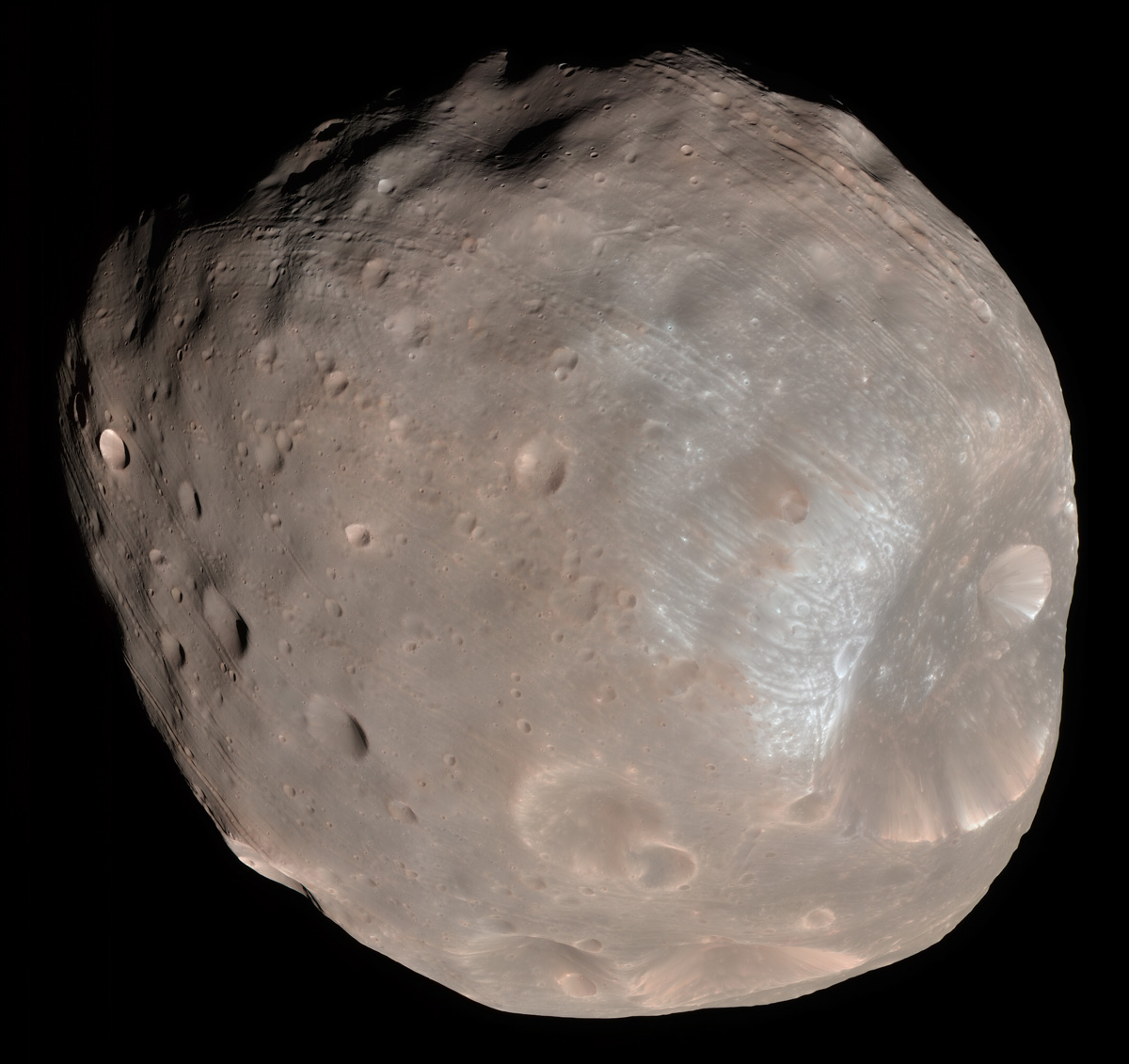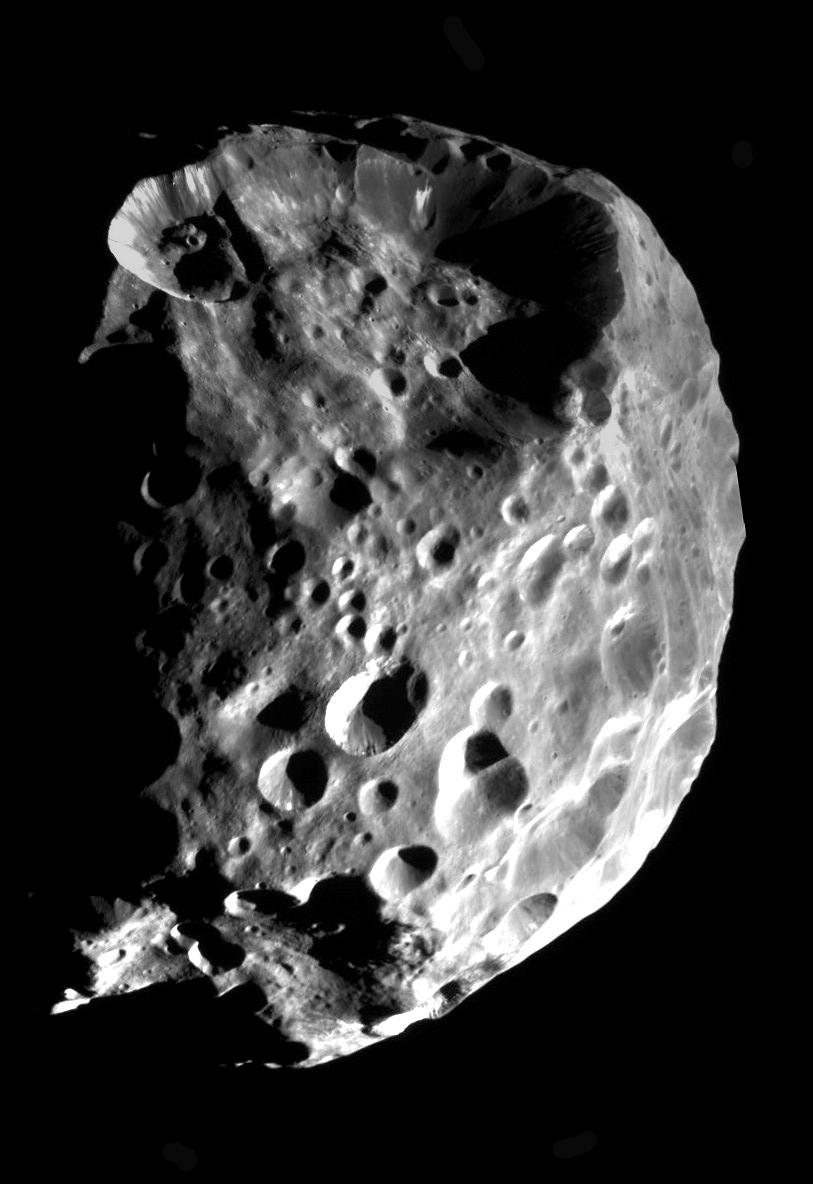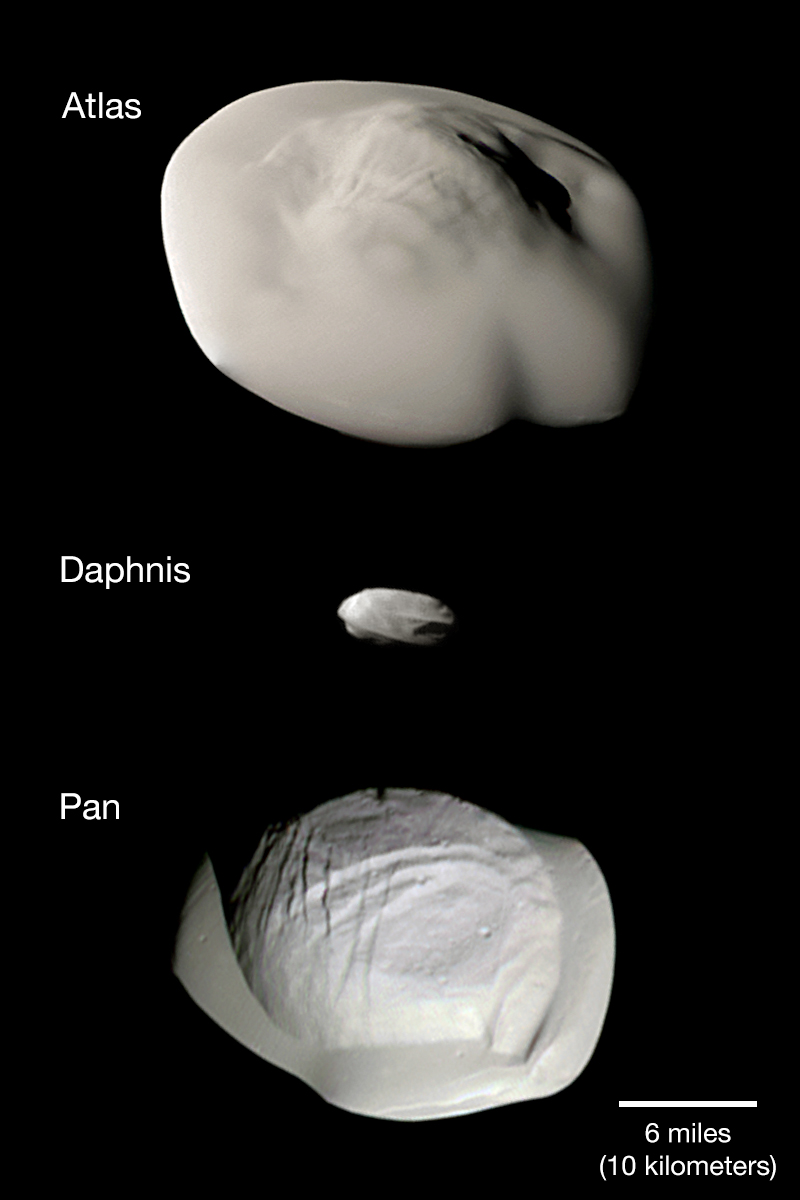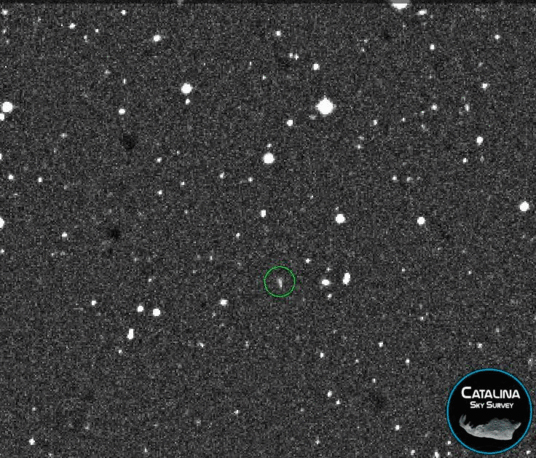

WEEK 33: AUGUST 9-15
TOPIC: SMALL PLANETARY MOONS
Throughout “Ice and Stone 2020” I have generally used the term “small bodies of the solar system” to refer to comets and asteroids. However, there is another type of “small body” that we encounter throughout the solar system: these are the smaller moons that accompany many of the major planets. The dividing line between what is and what is not a “small body” in this context is certainly a matter of definition, however I think it can be reasonably argued that objects like Earth’s moon, the four Galilean moons of Jupiter, Saturn’s moon Titan, and Neptune’s moon Triton, are all large and unique worlds in and of themselves. (Triton may well be a captured object from the Kuiper Belt, and is discussed within that context in other “Special Topics” presentations.) Some of Saturn’s other moons, and Uranus’ first five known moons, can perhaps also be argued as being “not-‘small’ ” in this same context. Many of the other planetary moons within our solar system, including almost all of those found in recent years, are, however, quite “small” in this context, and moreover are misshapen and non-spherical like many asteroids and comets, and thus are properly discussed within the context of “small bodies.”
The first two such objects to be discovered were the two moons of Mars. Mars had long been believed – not necessarily always for scientific reasons – to possess moons, and during the exceptionally close opposition of Mars in August 1877 – which, incidentally, was not much closer than the opposition on this coming October 13 – American astronomer Asaph Hall utilized the recently-constructed 66-cm refractor at the U.S. Naval Observatory in Washington, D.C. to search for such objects. Late on the evening of August 11 (August 12 UT) Hall detected a faint moving object near Mars, however poor weather prevented his confirming it until five nights later. After spotting the object again on the night of the 16th he saw it yet again on the following night, at which time he discovered another Martian moon.
The two new moons were named Phobos and Deimos (from the Greek mythological characters representing “fear” and “terror,” respectively). Deimos, the first of the two moons that Hall discovered, is the smaller and outer of the two, being about 15 by 12 by 11 km across and orbiting 20,000 km above Mars’ surface with an orbital period of 30.3 hours; Phobos, meanwhile, is 27 by 22 by 18 km across and orbits only 6000 km – less than two Mars radii – above Mars’ surface with an orbital period of 7.7 hours. Since Mars’ rotational period is slightly over 24.5 hours a ground-based observer on Mars would see Phobos rise in the west, transit the sky, and set in the east twice each day. Its angular size would be about 12 arcminutes, slightly over half the apparent diameter of the sun in that planet’s sky.
 Ground-based photograph of Mars and its two moons, taken July 25, 2018, around the time of Mars’ most recent opposition. Courtesy Reddit user bubbleweed.
Ground-based photograph of Mars and its two moons, taken July 25, 2018, around the time of Mars’ most recent opposition. Courtesy Reddit user bubbleweed.
Phobos and Deimos became the first of the solar system’s “small bodies” to be examined up close by a spacecraft, when NASA’s Mariner 9 mission photographed them in late October 1971 as it was approaching Mars for insertion into orbit. The two moons have been photographed extensively by the various Mars-orbiting missions since then, and can perhaps be considered as the best-studied of the solar system’s “small bodies.” Phobos has numerous craters, including a large 9-km-wide crater, Stickney (named for Asaph Hall’s wife Chloe Stickney), which has an accompanying system of grooves and chains of craters; Deimos, meanwhile, also has craters, but also smoother plains than does Phobos, as it appears that some of the craters have been filled in.

 Mars Reconnaissance Orbiter images of Mars’ two moons. Left: Phobos. Stickney is the larger crater at the lower right. Right: Deimos. Both images courtesy NASA.
Mars Reconnaissance Orbiter images of Mars’ two moons. Left: Phobos. Stickney is the larger crater at the lower right. Right: Deimos. Both images courtesy NASA.

distant future these will overcome Phobos’ internal strength and it will be ripped apart into pieces -- presumably to impact the Martian surface at some point afterwards.
Following the discovery of the four Galilean moons of Jupiter by the Italian astronomer Galileo Galilei in 1610, no additional moons of Jupiter were discovered for almost three centuries. Jupiter’s fifth-known moon was finally discovered on September 9, 1892 by American astronomer Edward Barnard, who spotted it visually with the 91-cm refractor at Lick Observatory in California. The new moon was named Amalthea and it is much smaller than the Galilean moons, being about 250 km across in its longest dimension, and it orbits well inward of Io. Amalthea has the distinction of being the last solar system moon to be discovered visually.
Up through the late 1970s six additional moons were discovered around Jupiter, all of these being quite small -- ranging in size from 16 to 60 km in diameter -- and orbiting well outside


What could perhaps be considered the first-known “small body” moon of Saturn is Phoebe, which was discovered by American astronomer William Pickering on March 18, 1899 on photographs that had been taken the previous August; it has the distinction of being the first planetary moon to be discovered via photography. Phoebe is somewhat large, with an average diameter of 213 km, and orbits Saturn quite distantly with an orbital period of 1.5 years; like some of the aforementioned outer moons of Jupiter, its orbit is retrograde.
In late 1966 Saturn’s rings were presented edge-on to Earth, and right around the time of the ring-plane crossing French astronomer Audouin Dollfus took advantage of the lack of glare from the rings to make searches for any small inner moons of Saturn. In mid-December he discovered such a moon, which he named Janus, however it later turned out that some of the astrometric positions of Janus could not be reconciled within a consistent orbit. By the late 1970s it was becoming apparent that what was believed to be Janus was actually two small moons traveling in the same orbit, and this second moon was later given the name Epimetheus. Janus is about 180 km in diameter and Epimetheus is slightly smaller with an average diameter of 120 km.
In 1980-81 Saturn’s rings were again presented edge-on to Earth, and the world’s astronomers took advantage of this to look for additional small moons close to Saturn. There were numerous reports of such objects, and meanwhile both Voyager spacecraft passed by Saturn during this same time frame (Voyager 1 in November 1980 and Voyager 2 in August 1981) and these detected four additional small inner moons. After all the various reports were sorted out there were a total of 18 known moons around Saturn; some of these occupied the same orbits of already-known larger moons (at their respective Lagrangian points) and some of the other newly-discovered ones were “shepherd moons” gravitationally confining the newly-discovered thin “F” ring of Saturn or some of the interior gaps in the previously-known rings. More recently, the Cassini mission which orbited Saturn between 2004 and 2017 discovered at least seven additional small inner moons as well as several tiny “moonlets” – with a diameter of a few hundred meters or less – which may or may not be “moons” depending upon how that term might be defined.

 LEFT: Saturn’s outer moon Phoebe, as imaged by the Cassini spacecraft on June 11, 2004 as it was approaching Saturn. Courtesy NASA. RIGHT: Montage of Cassini images of some of the “shepherd” moons of Saturn, to scale. Atlas orbits just outside the outer edge of the “A” ring, Daphnis orbits within the Keeler Gap in the “A” ring, and Pan orbits within the Encke Gap in the “A” ring. Courtesy NASA.
LEFT: Saturn’s outer moon Phoebe, as imaged by the Cassini spacecraft on June 11, 2004 as it was approaching Saturn. Courtesy NASA. RIGHT: Montage of Cassini images of some of the “shepherd” moons of Saturn, to scale. Atlas orbits just outside the outer edge of the “A” ring, Daphnis orbits within the Keeler Gap in the “A” ring, and Pan orbits within the Encke Gap in the “A” ring. Courtesy NASA.
Voyager 2 discovered eleven previously-unknown moons around Uranus when it passed by that planet in early 1986, although one of these was not identified in the Voyager images until over a decade later. Astronomers utilizing the Hubble Space Telescope discovered two additional small inner moons of Uranus in 2003. Meanwhile, in addition to Triton Neptune had one other known moon, Nereid, which was discovered by Gerard Kuiper in 1949; it has an approximate diameter of 340 km and travels in an elongated orbit with an orbital period of just under one year. Voyager 2 discovered seven additional moons of Neptune when it passed by that planet in August 1989; one of these, Proteus, is larger than Nereid (approximate diameter 420 km). Another small inner moon, named Hippocamp, was discovered in 2013 in images taken with the Hubble Space Telescope.
Starting in the late 1990s and extending for the next several years some astronomers made attempts to find very small distant outer moons of the solar system’s giant planets. These efforts were very successfully, and the number of known moons has grown dramatically since they started. Almost all of these moons are indeed very small, just a few km in diameter for those around Jupiter and Saturn, and a few tens of km in diameter for those around Uranus and Neptune. A relatively large percentage of these are in retrograde orbits. Especially in the case of Neptune, they are far enough away from the sun’s gravitational influence that they can orbit their planet distantly and still remain within that system; Neptune’s most distant moons, Psamathe and Neso, have average orbital distances close to 1/3 of an AU and have orbital periods of 25 and 26 years, respectively.
Most of these recently-discovered distant small outer moons have not been studied in any detail; no space missions have examined them, and they are too faint and small for detailed examinations with Earth-based instruments. (For example, the Saturn moons announced last year are all around 25th magnitude and all are 5 km across or smaller.) Since a significant number of them are traveling in eccentric and/or retrograde orbits, it is likely that many, if not

As far as can be determined, all of these moons are “permanent” in the sense that, at least over timescales of a few centuries, they are gravitationally bound to the planet that they are orbiting. This nevertheless raises the question as to whether or not there might exist “temporary” moons. Numerical simulations suggest that this situation can happen, and indeed it almost certainly does happen from time to time, although – especially in the case of Jupiter – such objects would eventually be scattered away.
There have actually been a few cases of comets that have been “captured” as temporary moons of Jupiter. The first clear example of such is Comet 82P/Gehrels 3, which studies have shown has experienced several episodes of being a temporary moon of Jupiter, most recently between 1967 and 1973 prior to its discovery in 1975. It will again be a temporary moon of Jupiter for a five-year period centered around 2060. The most famous example of a temporary cometary moon of Jupiter is Comet Shoemaker-Levy 9 1993e, the disrupted fragments of which impacted that planet in 1994; this was a previous “Comet of the Week” and these events are discussed in that object’s Presentation.
It turns out that Earth has recently had a couple of temporary second moons. The small asteroid 2006 RH120, discovered by the Catalina Sky Survey program in Arizona in September 2006, was found to be traveling in a geocentric orbit with an approximate orbital period of three months and a perigee distance close to the moon’s orbit. 2006 RH120 is only two to three meters in diameter and is likely a fragment of lunar rock blasted up after an impact, and after orbiting Earth for a little over a year and a half it left Earth orbit in mid-2007. It will return to Earth’s vicinity (0.028 AU) in August 2028 although this is probably not close enough to produce another “capture” at that time. For what it’s worth, 2006 RH120 is the top-ranked “easily retrievable” near-Earth object on the 2013 list prepared by Garcia Yarnoz et al. (discussed in the “Special Topics” presentation on “Resources in ‘Small Bodies’ ”).
Meanwhile, earlier this year, on February 15, 2020, Theodore Pruyne and Kacper Wierzchos with the Mount Lemmon Survey in Arizona discovered the asteroid designated as 2020 CD3. Like 2002 RH120, 2020 CD3 is a very tiny object, no more than two to three meters in diameter, and even though it was only followed for six weeks, this was enough to indicate that it had been in a geocentric orbit (with an approximate orbital period of eight weeks) since about 2015 or 2016, but after May 2020 it is escaping back into a heliocentric orbit. It will pass close to Earth again in 2044 but will probably remain far enough away so that it will not be “captured” into geocentric orbit again. From an overall perspective, the discovery of two such objects within the recent past suggests that this is a relatively common phenomenon; indeed, studies indicate that a bright fireball observed over the desert regions of South Australia on August 22, 2016 may have been a temporary “moon” of Earth prior to its entry into the atmosphere. With ever more comprehensive survey programs continuing to come on-line we will likely see more such discoveries within the years to come.

 Images of the recent temporary “Earth moon” 2020 CD3. Left: One of the discovery images, taken February 15, 2020, during the course of the Mount Lemmon Survey in Arizona (a part of the Catalina Sky Survey). Courtesy Catalina Sky Survey/Kacper Wierzchos. Right: Color image taken with the 8-meter Gemini North Telescope in Hawaii on February 24, 2020. Courtesy The International Gemini Observatory/NSF’s Optical-Infrared Astronomy Research Laboratory/AURA/Grigori Fedorets.
Images of the recent temporary “Earth moon” 2020 CD3. Left: One of the discovery images, taken February 15, 2020, during the course of the Mount Lemmon Survey in Arizona (a part of the Catalina Sky Survey). Courtesy Catalina Sky Survey/Kacper Wierzchos. Right: Color image taken with the 8-meter Gemini North Telescope in Hawaii on February 24, 2020. Courtesy The International Gemini Observatory/NSF’s Optical-Infrared Astronomy Research Laboratory/AURA/Grigori Fedorets.
In addition to the major planets, quite a few asteroids, both in the main asteroid belt and those that pass by Earth, have moons of their own, as do some of the Kuiper Belt objects (including Pluto, which is accompanied by its large moon Charon plus four more recently-discovered smaller moons). These objects are discussed in the appropriate “Special Topics” presentations.
“Special Topics” archive
Ice and Stone 2020 home page
Earthrise Institute home page